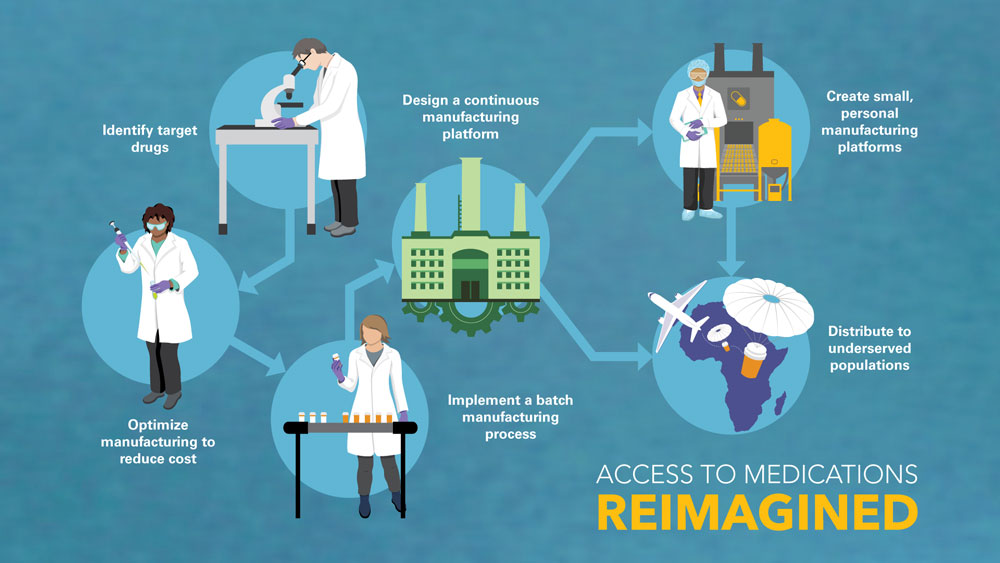Virginia Commonwealth University College of Engineering researchers are pushing forward with an initiative, Pharmacy on Demand, that represents a fundamental change in pharmaceutical manufacturing.
Thomas D. Roper, Ph.D., director of pharmaceutical engineering for the college and a professor of chemical engineering, will test and optimize new equipment arriving at VCU in November that was built by collaborators at the Massachusetts Institute of Technology. The arrival of this equipment — four modules, each about the size of a small refrigerator — marks another step toward creating an alternative drug manufacturing process with a miniaturized environmental and industrial footprint.
Such a compact, portable system could be deployed rapidly in case of an outbreak of disease or a drug shortage. As international market forces continue to leave the U.S. with critical drug shortages, leaders of the Pharmacy on Demand program imagine a future where global access to drugs is expanded and communities everywhere are empowered to meet their own needs for therapeutics.
Roper, who is a Center for Innovative Technology (CIT) Eminent Researcher, likens the concept to the advent of printers for personal computers. Rather than having to go to a copy shop or to the basement of a library to get computer printouts, he said, consumers today can use their own printers. The challenge is: “Can you do the same thing with medicines?”
Pharmaceutical manufacturing relies on traditional batch processing, which is conducted in many steps with stops and starts, requires huge factories and produces waste that poses industrial hazard risks. Designing an alternative to this current model using a continuous flow process requires new chemistry, cutting-edge chemical engineering and innovative processes. Yet the inspiration to bring the production of active pharmaceutical ingredients and medications closer to the patient comes from the past.
Geoffrey Ling, M.D., Ph.D., a neurologist and retired U.S. Army colonel who recruited Roper to the project, said the idea was to return to “apothecary roots,” when pharmacists would mix and dispense drugs to patients at the point of care.
Speaking at the inaugural Medicines for All Summit at VCU in November 2017, Ling described being frustrated with the lack of medications when he was stationed in northwest Afghanistan in 2003 and was treating a soldier with a severe brain injury at a combat support hospital. “If I had the recipe, and I had the starting materials,” he said, “I could make it myself.”
The project is being supported by a $2.2 million grant from the U.S. Defense Advanced Research Projects Agency.
In 2016, Pharmacy on Demand researchers at MIT created a portable streamlined system that was about the size of a full refrigerator to formulate liquid drugs.
The next step at VCU will be to continue to develop the smaller units and seek approval from the U.S. Food and Drug Administration to make ciprofloxacin tablets using an end-to-end continuous manufacturing process.
“Imagine you’re taking a pharmaceutical factory and you’re making it fit into four fridge-sized modules,” said Mariam Ibrahim, Ph.D., a postdoctoral fellow in the Department of Chemical and Life Sciences Engineering who is working on the project.
The first unit takes the starting materials and synthesizes the drug. The second and third modules purify, filter and dry the material. The fourth module creates the finished tablets. One of the first tests is having the system make 1,000 tablets of ciprofloxacin in a 24-hour period.
Roper said the MIT researchers made the machines out of interchangeable building blocks that could be switched around to create different drug formulations.
Ibrahim said if there were an outbreak of a disease in a place that is difficult to access, “if we have these units on site, we can manufacture the needed medications.” Producing the medications as needed also eliminates the challenges of storing the products safely. “Whenever you need it,” she said, “you just make it based on the demand you have.”
